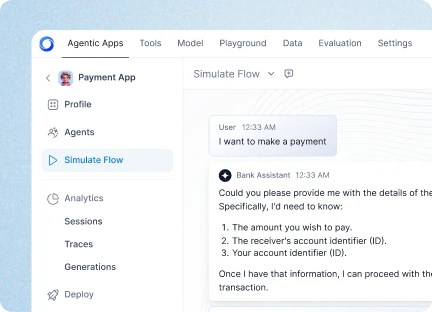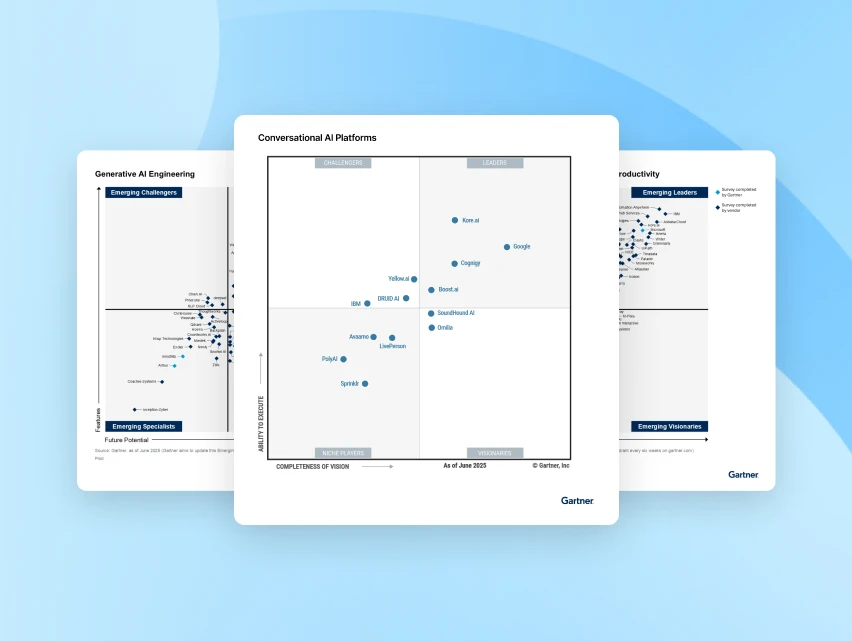Agentic AI in Banking: Transforming Intelligent Automation and Customer Experience
Introduction: Banking at the Cusp of Intelligent Autonomy
Global banking is entering a new phase, defined not just by digital transformation but by intelligent autonomy. Over the past decade, institutions have invested billions in modernization, yet many remain caught between technological progress and operational rigidity.
Despite years of transformation, efficiency gains and customer satisfaction have plateaued. Today’s customers expect instant, personalized, and error-free experiences, but legacy systems, fragmented data, and siloed operations continue to slow response times. Service resolution in many banks still hovers below par, while cost-to-income ratios exceed 55 percent. The result is a widening gap between what customers expect and what traditional institutions deliver.
The Operational Strain Beneath the Surface
Behind the industry’s digital facade lies mounting operational strain. Compliance requirements have increased as regulators demand greater transparency and traceability. Teams spend considerable time maintaining documentation and monitoring frameworks, tasks that are often repetitive, resource-intensive, and susceptible to fatigue. AI can simplify and streamline much of this work. At the same time, workforce dynamics are undergoing a shift. Experienced professionals are retiring faster than replacements can be trained, while attrition among frontline employees continues to climb. Many efficiency-focused systems, once accelerators, have evolved into hard-coded silos that limit responsiveness and real-time decision-making.
Banks are discovering that technology alone is not enough. What they need now is adaptive intelligence, capable of thinking, reasoning, and acting autonomously within regulatory boundaries.
Competitive pressures are resetting the industry baseline
The structure of competition in banking has changed irreversibly. Fintechs and digital-first banks have redefined the customer experience with cloud-native agility, real-time onboarding, AI-driven insights, and transparent pricing. These challengers innovate in weeks instead of months and operate at a fraction of traditional costs.
Incumbent banks face a dual challenge. They must match the adaptability of fintechs while preserving the governance, control, and trust that define their institutions.
The next frontier of AI in banking is not about more automation. It is about achieving intelligence, autonomy, and governance in unison. This is the domain of Agentic AI.
From Automation to Autonomy: The Agentic AI Shift
Banks have adopted multiple waves of automation and AI over the years, starting with rules-based tools like RPA and workflow engines, then moving to predictive models that improved scoring and classification, and later to conversational AI that made interactions more intuitive. The rise of Generative AI pushed these capabilities further by improving language understanding and content creation. Each of these technologies has delivered clear benefits, yet they all share a core limitation: they speed up tasks but don’t truly understand situations. They can follow logic, recognize patterns, or generate responses, but they still struggle with context, exceptions, and decisions that require reasoning. As banking operations grow more interconnected and dynamic, these systems alone can’t bridge the gap between efficiency and true intelligence.
Meeting today’s demands requires systems that do more than respond or automate, they must be able to interpret, reason, and act across complex processes. This is where Agentic AI enters the picture. It builds on everything that came before, automation, predictive analytics, conversational intelligence, and generative capabilities, and adds the missing layer of autonomous decision-making. Instead of just processing information, Agentic AI connects understanding with action, enabling adaptive and responsible execution across the enterprise. With this foundation clarified, we can now explore how Agentic AI reshapes operations, compliance, and customer experience in modern banking.
This evolution is already delivering measurable results.
- A leading global wealth management firm deployed AI agents that delivers accurate answers from a corpus of 100,000 documents, expands document access from 20% to 80%, and frees advisors to spend more time with clients through automated research and faster insights.
- A global financial institution uses an Advanced AI to manage over 300M annual customer interactions, support 50M+ consumers, and achieve up to 60% self-service containment with 95%+ intent accuracy across 300+ intents.
In this article, we explore how Agentic AI is redefining modern banking, driving intelligent operations, automated compliance, and hyper-personalized customer experiences. You’ll learn why Agentic AI matters, how leading banks are adopting it, the challenges they face, and the ways Kore.ai is enabling banks to realize their full potential.
Read More on Agentic AI here - What is Agentic AI?
Why Banks Need Agentic AI, and Why Now
After more than a decade of digital modernization, the industry now has the technology, data infrastructure, and regulatory clarity required to scale intelligent autonomy. Nearly 70 percent of financial institutions have migrated critical workloads to the cloud, and more than 60 percent operate API-enabled systems. These investments have created a foundation capable of supporting advanced, enterprise-grade intelligence.
Agentic AI builds on this foundation. It connects data, processes, and decision systems into a cohesive intelligence layer that can perceive context, reason about objectives, and act autonomously within governed parameters. This represents the next evolution in banking operations, where systems are no longer task executors but active decision-makers that interpret intent, adapt to changing conditions, and deliver faster and more accurate outcomes.
A Moment of Economic and Strategic Urgency
The economic case for transformation is stronger than ever. Cost-to-income ratios remain above 55 percent across major markets, and productivity gains from traditional automation have plateaued. At the same time, customer expectations have accelerated. Clients now demand personalized, real-time, and error-free interactions across every channel.
Agentic AI helps bridge this gap. By autonomously managing complex workflows such as KYC validation, claims processing, and risk monitoring, it can reduce operational costs by up to 30 percent and improve processing speeds by more than 40 percent. McKinsey estimates that AI could unlock more than 340 billion dollars in annual value for the banking industry. Banks adopting intelligent autonomy are achieving measurable efficiency, greater resilience, and new capacity for growth without proportional increases in headcount or infrastructure.
A New Class of Intelligence for Banking Services
Agentic AI represents a shift from programmed automation to systems that can perceive, reason, plan, act, and learn.
- Perceive data from transactions, documents, and customer interactions.
- Reason using policies, logic, and contextual understanding.
- Plan and coordinate tasks across departments and workflows.
- Act securely and autonomously within established boundaries.
- Learn continuously through feedback to improve accuracy and adaptability.
These capabilities enable banks to move from static process execution to intelligent orchestration, delivering consistent and auditable results at scale. A 2024 Gartner report indicates that more than 40 percent of global banks already use agentic AI across compliance, payments, and risk management. Deloitte reports that early adopters have achieved up to 50 percent faster processing and significant improvements in audit readiness.
Trust, Transparency, and Responsible Autonomy
Regulatory frameworks are evolving to support innovation through accountability. In the United States, the NIST AI Risk Management Framework and recent guidance from federal banking regulators emphasize governance, transparency, and model explainability. In Europe, the EU AI Act and the United Kingdom’s Prudential Regulation Authority (PRA) are setting clear expectations for oversight, traceability, and ethical deployment of intelligent systems.
The alignment across these regions reflects a shared goal: to ensure that AI innovation strengthens, rather than compromises, financial stability and consumer trust. According to the Bank of England’s 2024 AI in Financial Services survey, 72 percent of institutions now have executive-level accountability for AI adoption, and 24 percent of AI applications already operate with partial autonomy under human supervision.
Agentic AI fits naturally into this environment. It embeds transparency and control into every process. Each action is explainable, traceable, and fully auditable. Human-in-the-loop frameworks ensure that autonomy operates within defined boundaries, giving banks the confidence to scale intelligent systems responsibly while meeting the highest standards of governance across both markets.
The Foundation of Intelligent Banking
Technology maturity, regulatory clarity, and competitive urgency have converged. Banks that adopt Agentic AI are not just automating tasks but creating intelligent, adaptive systems that drive agility, transparency, and trust. The institutions that act now will define the next era of performance and resilience in banking services.
Benefits of Agentic AI in banking
Agentic AI is redefining the competitive frontier of global banking. It fuses reasoning, autonomy, and governance to convert technological potential into measurable business outcomes, delivering operational excellence, scalable efficiency, customer personalization, regulatory assurance, and smarter risk management. As global IT spending in banking/investment is forecast to increase by 8.2% in 2024 to $746.1 billion, with a 9.0% CAGR to exceed $1T by 2028, the need for transformative autonomy has never been clearer.
1. Operational Excellence and Efficiency at Scale
Agentic AI enables true end-to-end automation by allowing systems to execute multi-step workflows independently, spanning reconciliation, KYC, trade finance, and fraud monitoring.
- An Independent Bank reduced integration-pipeline development time 12 × and began detecting ATM fraud in real time.
- BNY Mellon’s “Eliza”, orchestrating 13 specialized agents, provides instant client insights and faster service delivery.
- Crédit Agricole Bank Polska, using Agentic AI, cut document-processing time by 50 %, saved 750 + hours per month, and improved customer satisfaction and team morale.
According to McKinsey & Company, intelligent-autonomy deployments reduce process cycle times by up to 50 % and improve end-to-end efficiency by ≈ 30 %.
By interpreting context and reasoning about intent, agentic systems maintain performance under high volumes while freeing human talent for strategic, high-judgment tasks.
2. Cost Optimization and Productivity Gains
Agentic AI directly enhances operating leverage. A Deloitte study found that Agetic AI will help save between 20% and 40% in software investments for the banking industry by 2028. McKinsey reports that scaled AI adoption can unlock US$200 - 340 billion annually in banking value through productivity and process redesign.
Early implementations indicate 60 % potential productivity gains and annual savings exceeding US $3 million per institution.
These improvements come from intelligent reallocation of effort, not workforce cuts, allowing employees to focus on innovation, analysis, and customer growth rather than manual validation.
3. Enhanced Customer Experience and Personalization
Customers demand seamless, instant, and personalized engagement across every channel. Agentic AI delivers this by combining contextual understanding with real-time reasoning.
- A leading Asian bank achieved a 25 % increase in customer satisfaction scores after introducing AI agents for service requests and account updates.
- A major universal bank leverages AI automation to handle over 600k conversations annually, save 22M Php in the first year, boost CSAT to 80%, and drive higher customer engagement through in-conversation rewards redemption.
By remembering context and predicting intent, agentic systems anticipate customer needs and resolve issues proactively, creating experiences that are fast, consistent, and human-centric.
4. Stronger Compliance and Risk Governance
Regulatory integrity is the foundation of trust. Agentic AI embeds compliance directly into workflows, logging every action for full traceability and alignment with the EU AI Act, NIST AI Risk Management Framework, Basel III, and DORA, etc
- The Bank of Singapore cut compliance-document drafting time by 20–50 % using generative AI while maintaining regulatory accuracy.
- Financial institutions applying AI to AML / KYC monitoring report ≈ 40 % higher anomaly-detection accuracy and materially shorter audit cycles.
In the U.S., the Federal Reserve and OCC emphasize transparency and model governance; the U.K.’s PRA demands explainability; and Singapore’s MAS promotes the FEAT principles, Fairness, Ethics, Accountability, and Transparency. Properly governed agentic systems satisfy these expectations by design, giving leaders a compliance advantage.
5. Continuous Innovation and Adaptive Agility
Agentic AI drives continuous improvement by orchestrating data, logic, and workflows across silos.
Banks can now launch new services faster, personalize offers in real time, and adapt instantly to regulatory or market changes.
- A major U.K. bank integrating AI agents into loan-approval workflows reduced loan fraud by 35 %.
- Leading institutions report 25–40 % faster loan approvals and 45–65 % fewer manual steps in trade-finance processing, creating a durable competitive advantage.
McKinsey projects that autonomous systems could expand banking productivity by 40 % + while cutting operational friction dramatically.
6. Smarter Risk Management and Resilience
Agentic AI strengthens enterprise-risk control through autonomous, real-time monitoring of credit, market, and liquidity exposures.
These systems dynamically adjust thresholds when volatility spikes, new counterparty data emerges, or regulations evolve. For executives, this delivers faster, more consistent risk assessment and greater institutional stability, enhancing both profitability and resilience under stress.
7. Security and Governance for Sensitive Financial Data
Agentic AI can be secure if governed correctly. Deployments should follow the three-lines-of-defense model covering:
- Model performance – continuous validation, explainability, fairness, and drift detection.
- Operational resilience – third-party oversight, zero-trust architecture, encryption, and graceful-degradation plans.
- Regulatory and reputational exposure – supervisory engagement, transparent customer disclosures, and human-in-the-loop escalation paths.
These safeguards ensure autonomy operates with accountability and maintain trust in AI-driven banking.
A New Performance Curve for Banking
Agentic AI is no longer experimental; it is delivering measurable impact today. Efficiency builds capacity. Compliance ensures credibility. Personalization drives loyalty. Innovation fuels growth. Banks implementing agentic systems are already seeing:
- 25–40 % faster loan approvals
- 45–65 % reduction in manual trade-finance processing
- Up to 80 % fewer manual interventions in compliance workflows
Together, these outcomes define a new performance curve, one grounded in intelligence, transparency, and speed.
Agentic AI is not just another wave of digital transformation; it is the foundation of intelligent, resilient, and continuously evolving financial institutions.
Key use-cases of Agentic AI in banking
Practical deployment is where value becomes visible. Banks are now applying intelligent systems across critical domains to compress cycle times, strengthen compliance, and scale decision-making. The following use cases illustrate where these systems are already generating measurable results.
Banking Domain
Core Applications
Measured or Projected Impact
Industry Insight
1. Retail and Digital Banking
• End-to-end customer service automation
• Dispute and chargeback resolution
• Proactive alerts and service recovery
• In retail banking, containment rates have reached 80 to 90 percent, extending earlier productivity gains into customer service
• Handling time reduced by up to 35 percent
• Significant uplift in CSAT and NPS
• Deloitte reports agentic AI driving smoother, faster, and more personalized digital journeys.
• Gartner notes customer service as one of the earliest and most successful adoption areas.
2. Commercial and SME Banking
• Automated SME onboarding and KYC
• Loan processing and credit memo generation
• Relationship manager copilots
• More than 60 percent reduction in onboarding and lending cycle times
• Faster time-to-revenue and stronger compliance consistency
• Everest Group highlights that agentic AI enables contextual decisioning and multi-system orchestration for SME lending.
3. Payments and Treasury Operations
• Exception tracing and recall
• Real-time fraud detection
• Treasury optimization and cash sweeps
• 20 to 35 percent cycle-time reduction across middle- and back-office workflows
• Up to 70 percent faster reconciliation
• Gartner predicts that by 2027, adoption of agentic AI will expand significantly across back-office workflows, including reconciliations and sanctions checks.
• Industry studies confirm that multi-agent architectures now process payments end-to-end with embedded validation and auditability.
4. Risk, Compliance, and Financial Crime
• Automated KYC and AML checks
• Regulatory documentation and Source of Wealth reports
• Continuous compliance monitoring
• Noticeable improvement in compliance accuracy, with shorter audit cycles and faster anomaly detection
• Gartner indicates that over 70 percent of banks already use AI for AML and KYC augmentation.
• EU and UK regulators are embedding explainability and traceability into AI adoption standards.
5. Wealth and Private Banking
• Portfolio monitoring and insights• Automated Source of Wealth documentation
• Personalized client engagement and recommendations
• Document preparation time reduced from days to hours
• 30 to 35 percent increase in advisor productivity
• Salesforce finds AI agents increasing advisor capacity and improving documentation quality.
• BCG highlights AI orchestration as a key driver of personalization in wealth management.
6. Internal and Employee Operations
• AI-powered HR, IT, and finance helpdesks
• Knowledge retrieval across enterprise systems
• Process performance analytics
• Faster internal query resolution
• Lower service costs
• Higher employee satisfaction
• Deloitte research links agentic systems to improved employee enablement and cross-functional knowledge access.
• TechRadar warns that 78% of banks remain data unready, a gap internal AI agents can help close.
The broader outcome
Across these domains, measurable benefits are converging: shorter cycle times, lower cost-to-serve, higher compliance accuracy, and faster revenue realization. Gartner expects adoption to accelerate through 2027 as banks embed autonomous agents into regulated workflows. Consultancies such as Deloitte and BCG describe this shift as the rise of the AI-augmented operating model, where human expertise focuses on supervision, coaching, and ethical oversight rather than routine execution.
The institutions leading this evolution are not adding tools; they are rebuilding operating discipline around autonomy, governance, and intelligence at scale.
Is Agentic AI Secure Enough for Sensitive Financial Data?
Yes, but only when it operates within rigorous safeguards that combine validation, resilience, and transparency.
- Continuous oversight is essential. Banks are shifting from periodic model reviews to real-time monitoring, using automated drift detection, challenger models, and statistical controls to flag performance deviations early.
- Explainability is built in by design. Executives require business-level reasoning, risk teams need algorithmic transparency, and auditors must access detailed, traceable decision records.
- Fairness monitoring ensures ethical performance, with automated alerts when decision patterns deviate from established standards or introduce bias.
- Operational resilience demands strict oversight of data and third parties. Institutions are enforcing vendor audits, verifying model lineage, and maintaining clear documentation of data sources and usage.
- Cyber safeguards now follow zero-trust principles, including encryption in transit and at rest, multi-factor authentication, and controlled network segmentation to limit exposure.
- Fallback mechanisms and manual override procedures maintain business continuity if AI agents malfunction or require suspension, ensuring critical operations remain uninterrupted.
- Governance logic is increasingly embedded directly into workflows so that every automated action is logged, reviewed, and explainable in real time.
- Transparency to customers is vital. Banks must clearly disclose how AI influences lending, pricing, and fraud decisions while providing easy escalation channels for human review or appeal.
- Human-in-the-loop oversight remains the foundation of accountability, maintaining control and confidence as automation scales.
Agentic AI can securely manage sensitive financial data only when institutions treat governance, validation, and transparency as integral to design, not as post-deployment checks. Banks that build these principles into their architecture will lead the next generation of secure, trusted, and responsible digital finance.
Challenges in adopting Agentic AI in banking
The potential of Agentic AI in banking is undisputed, but scaling it across global institutions is complex. The toughest barriers are not technical; they stem from readiness, governance, organizational design, and risk appetite. Overcoming these challenges determines whether AI becomes a controlled pilot or a sustainable enterprise capability.
1. Data Readiness and Integration
Reliable, unified, and contextual data remains the foundation for intelligent autonomy. Yet 78 percent of banks are still “data-unready” to support enterprise-scale AI. Legacy systems, fragmented databases, and inconsistent APIs prevent agents from accessing timely, accurate insights. Leaders are addressing this by upgrading to real-time data pipelines, enforcing strong lineage and quality controls, and linking agents directly to authoritative sources such as KYC registries and compliance databases. The result is higher accuracy, better explainability, and transparent decision-making across workflows.
2. Governance, Explainability, and Compliance
As agentic systems assume greater decision authority, governance becomes non-negotiable.
The EU AI Act, UK PRA principles, and US NIST AI Risk Management Framework all demand documentation, transparency, and human oversight for high-risk models.
Gartner forecasts that AI-generated outputs will soon be treated as auditable financial decisions.
Progressive banks are embedding “governance-as-code” into design, ensuring every decision is logged, reviewable, and explainable, turning compliance from a regulatory burden into an operational advantage.
3. Organizational Design and Accountability
Scaling autonomy requires structural clarity. Banks are introducing central AI oversight committees comprising the CRO, CTO, CDO, and business heads to manage early-stage governance. As systems mature, responsibility transitions to specialized sub-committees within each business line.
A modern three-lines-of-defense model is emerging:
- Business units own system performance and customer outcomes.
- Risk management validates models, monitors compliance, and defines governance standards.
- Internal audit independently assesses effectiveness and regulatory alignment.
This model anchors autonomy within a disciplined framework of accountability.
4. Risk Appetite and Policy Integration
Defining acceptable AI risk is one of banking’s newest governance frontiers. Institutions must quantify how much uncertainty they are willing to accept around accuracy, bias, and reliability. Leading practices include:
- Establishing quantitative limits for accuracy, bias, and complaint thresholds alongside qualitative expectations for human oversight.
- Integrating AI governance into existing frameworks, model risk management, vendor oversight, operational risk, and business-continuity policies to avoid governance silos and blind spots.
5. Workforce Transformation and Cultural Readiness
Agentic AI is changing work, not removing it. Roles are evolving from execution to supervision, validation, and ethical oversight.
McKinsey finds that institutions investing equally in technology and reskilling achieve up to 50 percent higher returns on AI initiatives. Successful programs focus on:
- Leadership alignment: ensuring senior executives champion AI adoption and embed it in incentives.
- Employee engagement: equipping teams to move from “doers” to “controllers,” with comprehensive training in oversight, exception handling, and ethical review.
- Human-in-the-loop frameworks: giving employees authority to review or override agentic decisions, preserving accountability while strengthening trust.
6. Measuring ROI and Operating-Model Alignment
The business value of Agentic AI extends beyond cost reduction, but measuring it demands new metrics and governance disciplines.
Gartner cautions that most AI initiatives will fail to achieve sustainable ROI without redesigned data and operating models. Leading banks are adopting LLMOps and continuous-governance platforms to monitor performance, bias, and compliance in real time.
These frameworks enable autonomous scaling within controlled parameters, balancing innovation with enterprise discipline.
7. Integration Architecture and Infrastructure Readiness
Agentic systems depend on seamless connectivity. Legacy integrations such as screen-scraping or batch transfers create fragility and security risk. Modern architecture principles emphasize:
- API-first design to enable scalability and interoperability.
- Privacy-by-design controls, encryption, and access segmentation.
- Unified data architecture supporting real-time decisioning with traceable lineage and regulated data use.
Banks that modernize integration early can expand autonomy safely and at lower cost.
8. Emerging Risks and AI Security
Autonomy expands the threat surface. The Federal Reserve notes rising deepfake and synthetic-identity fraud, while Deloitte highlights privacy-first defense strategies, including tokenization, on-device inference, and continuous anomaly detection.
Embedding AI governance within cybersecurity frameworks, including zero-trust models and adaptive monitoring, is now essential to maintaining resilience and regulator confidence.
From Barriers to Building Blocks
Every challenge, from data quality and governance to workforce readiness and cybersecurity, can evolve into a foundation for maturity when addressed methodically.
Leading banks are:
- Modernizing data and integration pipelines
- Embedding compliance directly into code and workflows
- Redesigning roles around supervision and accountability
- Aligning innovation with clearly defined risk appetites
In this next phase of intelligent banking, maturity will be defined not by the speed of deployment, but by the depth of responsibility. Institutions that balance autonomy with governance will set the benchmark for performance, transparency, and trust in the age of intelligent finance.
How is Kore.ai helping Banking Industry
Banks are adopting Kore.ai’s AI for Banking to modernize service delivery, improve compliance, and scale operations securely. Purpose-built within Kore.ai’s AI for Service suite, the solution combines Agentic AI, LLM orchestration, and agentic reasoning, enterprise-grade conversational intelligence to deliver connected, compliant, and personalized experiences across retail, commercial, and corporate banking.
At its core, AI for Banking is a pre-trained industry accelerator equipped with thousands of banking-specific intents and workflows. It enables financial institutions to automate processes such as customer onboarding, KYC and AML checks, card servicing, loan management, payments, and fraud claims, reducing manual effort while improving accuracy and speed.
Technical Capabilities Include:
- Agentic Self-Service: AI agents engage customers through natural, multi-turn conversations to resolve tasks like fund transfers, transaction disputes, or card management instantly and autonomously.
- Intelligent Agent Assistance: Provides real-time recommendations, next-best actions, and AI-generated summaries to support human agents during complex transactions.
- KYC, AML, and Risk Automation: Automates regulatory workflows with integrated policy enforcement, identity verification, and anomaly detection.
- Payment and Card Operations: Handles authentication, transaction inquiries, and dispute management across multiple channels with full traceability.
- Fraud Detection and Dispute Resolution: Uses contextual reasoning and event-driven orchestration to detect anomalies and escalate cases efficiently.
- Omnichannel Orchestration: Connects seamlessly across voice, chat, web, mobile, and social platforms for consistent customer engagement.
- Integrations and Infrastructure: Connects with Finacle, Temenos, FIS, Fiserv, Salesforce, and other core systems via pre-built APIs; supports on-premise, hybrid, and private-cloud deployments for data control and scalability.
- Security and Compliance: Certified for SOC 2 Type II, ISO 27001, PCI DSS, and GDPR compliance, ensuring every workflow is secure, explainable, and auditable.
- No-Code Customization: Built on the Kore.ai Agent Platform, enabling institutions to design and deploy new workflows, tune models, and customize intent libraries without coding.
Banks deploying Kore.ai’s AI for Banking report 85–90% containment, up to 40% faster resolution times, and up to 50% reduction in operational costs, demonstrating how intelligent autonomy, governance, and personalization can drive measurable transformation.
Conclusion: The Future of Banking Is Autonomous, Intelligent, and Human-Centered
Banking is entering a defining decade, one where intelligence, trust, and adaptability will determine long-term competitiveness. Agentic AI marks the next frontier in this evolution, transforming institutions from process-driven enterprises into context-aware ecosystems that learn, decide, and act with precision.
The banks that lead this transition will do more than digitize workflows; they will redefine operating models around continuous learning, transparent governance, and real-time decisioning. In this new paradigm, efficiency is not the end goal but the foundation for resilience, agility, and deeper customer relationships.
The opportunity is clear: to build financial institutions that are as intelligent as they are accountable, where human judgment and machine reasoning work in concert to deliver trust at scale. The era of intelligent banking has begun, and those who act now will shape its trajectory.












.webp)





